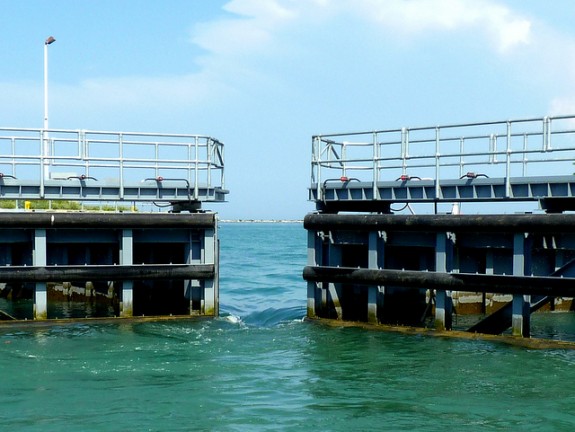Ongoing Drought Could Send the Chicago River Flowing in Reverse
Low water levels in Lake Michigan could cause the Chicago River to start flowing the other way

A series of locks separate the Chicago River from Lake Michigan. Photo: Ann Fisher
The ongoing U.S. drought—the same one that nearly shut down shipping traffic on the Mississippi River, that sapped groundwater stores, threatened the purchase price of pork, and raised the specter of another Dust Bowl—may have yet another surprise in store. High temperatures and a dearth of rainfall have driven the water level in Lake Michigan, one of the Great Lakes, to a record low, and this precipitous drop could cause the Chicago River to start flowing backwards as the river finds itself riding higher than the lake.
“If Lake Michigan’s water level drops by just 15 centimeters,” says The Weather Network, “it will be lower than the Chicago River. That could reverse the water flow, sending untreated sewage into Lake Michigan.”
From Chicago’s local ABC news:
“We’ve been monitoring since 1918 and this is the lowest Lake Michigan and Lake Huron have been,” Roy Deda, U.S. Army Corps of Engineers, said. “There would be some potential water quality impact to the Great Lakes if we were to continue to lock vessels when the river is higher than the lake.”
“Our river is 70-percent sewage. I think we need to recognize that. This is an open sewer. It depends upon gravity to go away from us. If that gravity does not work with the lake going down, it goes the other way, and we have done nothing to deal with the contaminants that we need to actually invest in fixing,” Henry Henderson, Natural Resources Defense Council
As it stands, the Chicago River is actually already “6/100ths of an inch” higher than the lake, says Fox News. And, standing between the river and the lake is a system of locks, used for moving ships between the two bodies of water, that could be held closed to prevent a backwash. According to Fox, “The lake’s level was even lower in 1964 than it is now, according to the operations manager for the water reclamation district.”
This is not the first time the Chicago River has faced an impending reversal in recent memory. In 2010, then Chicago mayor Richard Daley wanted to intentionally reverse the river’s flow in a bid to prevent invasive species from reaching the Great Lakes.
Indeed, the Chicago River’s current course is, actually, the opposite of the way nature designed it. In 1900, a grand engineering endeavor flipped the river’s flow direction, causing it to travel not towards Lake Michigan but towards the Mississippi River.
More from Smithsonian.com:
Watch Drought Dry Up America’s Groundwater
U.S. Faces Worst Drought Since 1956
70 Percent of Illinois Is In A Drought (And It’s Better Off Than Indiana)
/https://tf-cmsv2-smithsonianmag-media.s3.amazonaws.com/accounts/headshot/smartnews-colin-schultz-240.jpg)
/https://tf-cmsv2-smithsonianmag-media.s3.amazonaws.com/accounts/headshot/smartnews-colin-schultz-240.jpg)